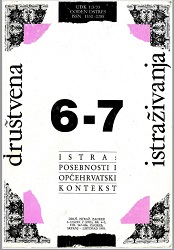PROMJENE NARODNOSNOG SASTAVA ISTRE - PROSTORNA ANALIZA POPISNIH PODATAKA 1880-1991.
CHANGES IN THE ETHNICAL STRUCTURE OF ISTRIA CENSUS AND SPATIAL ANALYSES 1880-1991
Author(s): Željka Richter, Vesna Kušar, Mladen KlemenčićSubject(s): Social history, Recent History (1900 till today), Culture and social structure , Evaluation research, Demography and human biology, 19th Century, Ethnic Minorities Studies
Published by: Institut društvenih znanosti Ivo Pilar
Keywords: Ethnical structure of Istria; 1880-1991;
Summary/Abstract: ln the paper census results in 1880-1991 period have been analysed in spite of methodological differences between censuses. In the examined period in Croatian peninsular region of Istria significant changes of ethnical structure have happened. Both, population and ethnical structure changes were influenced by two world wars, long-lasting italianization, emigration (by option) to Italy since 1947 and contemporary development of tourism. In spite of changes Istria has generally always been region with Croatian majority. Formerly numerous Italian community decreased after the World War II. A special consideration was given to spatial aspects of census data. Croatian majority is especially obvious if watched through spatial distribution. Therefore, cartographic method of analyses is with no doubt the most precise one. The latest census, carried out in 1991, shown a respectfull number of inhabitants declared "in the sense of regional affiliation" which made Istria being the exception in Croatia. However, that fact resulted from the borderland's composite inheritance. Croatian Istria was formerly a part of wider geographical and political unit and therefore in that ethnically Croatian region there is a strong feeling of regional identification.
Journal: Društvena istraživanja - Časopis za opća društvena pitanja
- Issue Year: 2/1993
- Issue No: 06+07
- Page Range: 607-629
- Page Count: 23
- Language: Croatian

